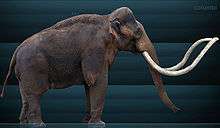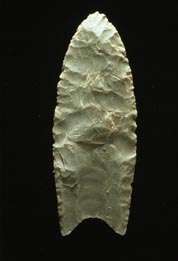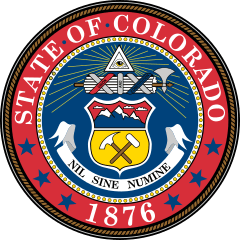Dent Site
Dent Site is a Clovis culture (about 11,000 years before present) site located in Weld County, Colorado, near Milliken, Colorado. It provided evidence that man and mammoth co-existed in the Americas.


Image courtesy of the Virginia Dept. of Historic Resources.
The site is located on an alluvial fan alongside the South Platte River.[1]
Discovery
Following a period of heavy rainfall and flooding in 1932, Frank Garner, Union Pacific Railroad employee, discovered large animal bones that were exposed near the Dent railroad station. The Dent Site, in Weld County, Colorado, was a fossil mammoth excavation for most of 1932. The first Dent Clovis point was found November 5, 1932 and the in situ point was found July 7, 1933. [2][3]
Findings
Clovis culture
The Clovis culture (about 13,300 - 12,900 calendar years before present)[4] used projectile points in hunting. Previous to the use of projectile points, indigenous people used a tool-kit like that used in Asia, which included large axe cutting tools, scrapers, blades and flake tools. The Clovis point was the first use of large, symmetrical and fluted projectile points.[5][6][nb 1]
Mammoth bones
Mammoth bones and what were later called Clovis points[nb 2] were found at the Dent Site in 1932. The site was notable for both the presence of the projectile points larger than the known Folsom points and one of the first direct pieces of evidence that man and mammoth co-existed in the Americas.[9][nb 3] The mammoth killed were not part of a family group, as originally hypothesized, and were not related to other mammoth killed at Clovis sites, such as Blackwater, New Mexico and Miami, Texas.[10]
Excavations
| Year | Name | Organization | Period and artifacts | Comments |
|---|---|---|---|---|
| 1932 | Father Conrad Bilgery | Regis University | Columbian mammoth (Mammuthus columbi) bones and projectile points later identified as Clovis points. | Father Conrad Bilgery at Regis College was notified following the discovery who conducted an initial excavation of the site.[2] |
| 1933 | Jesse Dade (J.D.) Figgins | Denver Museum of Natural History | At least 12 mammoth, mostly young or female. Figgins believed rocks 12 inches (30 cm) were brought in to assist the kill. | Figgins was considered the "Early Man expert" due to his work at the Folsom Site in New Mexico.[11] |
| 1973 | Joe Ben Wheat, Marie Wormington, Frank Frazier, Vance Haynes | University of Colorado | Total of 15 mammoth. | Radiocarbon dating of 11,200 +/- 500 years before present.[12][13] |
| 1987 | Robert Brunswig, Jr. | University of Northern Colorado | Total of 15 mammoth, 10 young and 5 adults (22-43), with evidence of butchering. | Radiocarbon dating was performed again, with dates 10,590 +/- 500 years before present and 10,950 +/- 480 years before present, at the low end of the estimated range from 1973. The killings were estimated to have been committed during the fall. Plants of the late Pleistocene period were found in mammoth teeth tarter: grass, prickly pear, bark and riverine plants.[14] |
See also
- Game drive system
- Manis Mastodon Site - dated to around 14,000 years old
Notes
- Clovis culture was considered the first culture to use projectile points to hunt on the North American continent. Since then, a pre-Clovis site was found in Manis, Washington that found use of projectile points to hunt mastodons.[7]
- John Colter identified the Dent site projectile points as Clovis points when he worked on the Blackwater Draw site near Clovis, New Mexico in 1936-1937.[8]
- The Burnet Cave article identifies itself as the first place that Clovis points were located.
References
- Hoppe, Kathryn A. (2004). "Late Pleistocene mammoth herd structure, migration patterns, and Clovis hunting strategies inferred from isotopic analyses of multiple death assemblages." Archived 2006-07-15 at the Wayback Machine Paleobiology. 30(1):135. On p.7 of the pdf file.
- Cassells, E. Steve. (1997). The Archaeology of Colorado, Revised Edition. Boulder, Colorado: Johnson Books. p. 58. ISBN 1-55566-193-9.
- The Search for the First Americans. Sangres.com. Retrieved December 1, 2011.
- Stiger, Mark. (2001) Hunter-Gatherer Archaeology of the Colorado High Country. Boulder: University Press of Colorado. ISBN 0-87081-612-8.
- Cassells, E. Steve. (1997). The Archaeology of Colorado, Revised Edition. Boulder, Colorado: Johnson Books. pp. 50-58, 64. ISBN 1-55566-193-9.
- People of the Poudre: Paleo-Indian Occupancy (12,000 - 7,500 BP) Fort Collins Museum, City of Fort Collins. 1996-2009. Retrieved December 1, 2011.
- Sindya N. Bhanoo (October 20, 2011). "Big-Game Hunt Adds to Evidence of Early North American Settlement". New York Times. Retrieved 2011-10-11.
- Cassells, E. Steve. (1997). The Archaeology of Colorado, Revised Edition. Boulder, Colorado: Johnson Books. pp. 64. ISBN 1-55566-193-9.
- Cassells, E. Steve. (1997). The Archaeology of Colorado, Revised Edition. Boulder, Colorado: Johnson Books. pp. 53, 58. ISBN 1-55566-193-9.
- Hoppe, Kathryn A. (2004). "Late Pleistocene mammoth herd structure, migration patterns, and Clovis hunting strategies inferred from isotopic analyses of multiple death assemblages." Archived 2006-07-15 at the Wayback Machine Paleobiology. 30(1):135, 139-140. On pp. 7, 11-12 of the pdf file.
- Cassells, E. Steve. (1997). The Archaeology of Colorado, Revised Edition. Boulder, Colorado: Johnson Books. pp. 58-60. ISBN 1-55566-193-9.
- Cassells, E. Steve. (1997). The Archaeology of Colorado, Revised Edition. Boulder, Colorado: Johnson Books. pp. 60-62. ISBN 1-55566-193-9.
- Haynes, Gary. (2002). The early settlement of North America: the Clovis era. Cambridge University Press. pp. 56-57. ISBN 0-521-81900-8.
- Cassells, E. Steve. (1997). The Archaeology of Colorado, Revised Edition. Boulder, Colorado: Johnson Books. pp. 62-64. ISBN 1-55566-193-9.
Further reading
- Brunswig, Robert H; Pitblado, Bonnie L. (editors). (2007). Frontiers in Colorado Paleoindian Archaeology, From the Dent Site to the Rocky Mountains. University of Colorado Press. ISBN 978-0-87081-890-5.
- Haynes, Gary. (1993). Mammoths, mastodonts, and elephants: biology, behavior, and the fossil record. Cambridge University Press. ISBN 0-521-45691-6.

